War dominated 30 years of Vietnam’s history last century. The struggle that began with communists fighting French colonial power in the 1940s did not end until they seized Saigon and control of the whole country in 1975. The period that Americans refer to as the “Vietnam War” – and the Vietnamese call the “American War” – was the US military intervention from 1959 to 1973.
The Vietnam War was a long, costly armed conflict that pitted the communist regime of North Vietnam and its southern allies, known as the Viet Cong, against South Vietnam and its principal ally, the United States. The divisive war, increasingly unpopular at home, ended with the withdrawal of U.S. forces in 1973 and the unification of Vietnam under Communist control two years later. More than 3 million people, including 58,000 Americans, were killed in the conflict.
The US was driven by Cold War concerns about the spread of communism, particularly “domino theory” – the idea that if one Asian nation fell to the leftist ideology, others would quickly follow. The Vietnam War was protracted and bloody. The Hanoi government estimates that in 21 years of fighting, four million civilians were killed across North and South Vietnam, and 1.1 million communist fighters died.

A med evac off Mutters Ridge, 2nd Bn 3rd Marines.
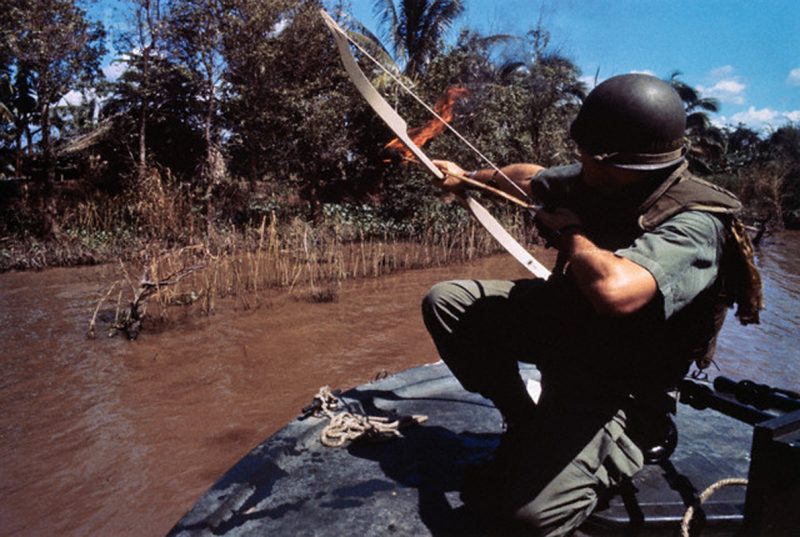
A Navy lieutenant aims his flaming arrow at a hut across the river that conceals a Viet Cong bunker.
Marines of Delta 1/5 caring for their wounded at HUE, 1968
Rare picture of an HH-43 Pedro evacuating casualties during operation Abilene.
Khe Sanh, South Vietnam – April 12, 1971
B-52 Vietnam war – Air Force soldier with no magazine in weapon (Guam or Thailand?)
Tunnel rat Melvin Sherrell, KIA December 13, 1966.
An RTO carrying his ruck incorrectly while crossing the stream, most likely only temporary!
The United States began drastically reducing their troop support in South Vietnam during the final years of Vietnamization. Many U.S. troops were removed from the region, and on 5 March 1971, the United States returned the 5th Special Forces Group, which was the first American unit deployed to South Vietnam, to its former base in Fort Bragg, North Carolina.
Under the Paris Peace Accords, between North Vietnamese Foreign Minister Lê Đức Thọ and U.S. Secretary of State Henry Kissinger, and reluctantly signed by South Vietnamese president Thiệu, U.S. military forces withdrew from South Vietnam and prisoners were exchanged. North Vietnam was allowed to continue supplying communist troops in the South, but only to the extent of replacing expended materiel. Later that year the Nobel Peace Prize was awarded to Kissinger and Thọ, but the Vietnamese negotiator declined it saying that a true peace did not yet exist.
The communist leaders had expected that the ceasefire terms would favor their side. But Saigon, bolstered by a surge of U.S. aid received just before the ceasefire went into effect, began to roll back the Viet Cong. The communists responded with a new strategy hammered out in a series of meetings in Hanoi in March 1973, according to the memoirs of Trần Văn Trà.
As the Viet Cong’s top commander, Tra participated in several of these meetings. With U.S. bombings suspended, work on the Ho Chi Minh trail and other logistical structures could proceed unimpeded. Logistics would be upgraded until the North was in a position to launch a massive invasion of the South, projected for the 1975–76 dry season. Tra calculated that this date would be Hanoi’s last opportunity to strike before Saigon’s army could be fully trained.
An RTO guides a Chinook delivering a sling load of materials and supplies at Fire Support Base Pershing, near Dau Tieng. Name and date unknown.
A LRRP team leader, unit D, 1st Squadron, 4th Cavalry, 1st Infantry Division makes it signals his men during a patrol in 1967.
M551 Sheridan of the 11th Armored Cavalry Regiment.
American soldiers after burning a village.
A young Marine goes into battle. Vietnam, 1965. Photograph by Eddie Adams
American F-4C Phantom jet streaming contrails from wingtips while regaining altitude after bombing small village known to be a Vietcong stronghold during Vietnam War.
American infantrymen look up at the tall jungle trees seeking out Viet Cong snipers firing at them. June 15, 1967
U.S. Army 2nd Lt. R.C. Rescorla, Platoon Leader of 2nd Battalion, 7th Cavalry Regiment, 1st Cavalry Division – Ia Drang Valley, South Vietnam. November 16, 1965. Born in England, he first served in the British Army, then joined the U.S. Army. Rick Rescorla, who was head of security for banking firm Morgan Stanley Dean Witter, is credited with saving 2,700 people by making sure they left the World Trade Center’s South Tower before it collapsed. He was killed when he went back in to rescue more people. (Colourised by Doug Banks)
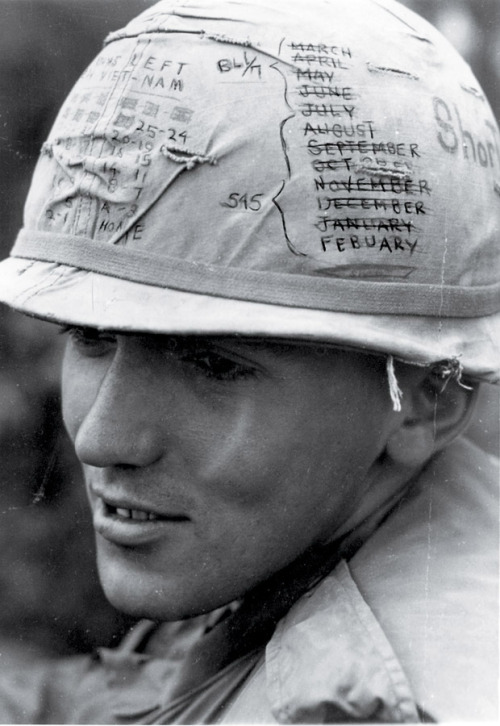
Getting very “short,” a 1st Air Cav trooper near Bong Son keeps close track of his last remaining days in Vietnam (SPC5 Frank Moffitt/U.S. Army/National Archives).
LCpl William G. Cox emerging from a VC tunnel discovered in the Batangan Peninsula. When mapped, it was over 158 yards long and two levels deep.
Operation “Billings” Medic from the 1st Battalion, 16th Infantry, 1st Infantry Division, searches the sky for a Medevac helicopter to evacuate a wounded buddy, following air assault into LZ Rufe in June 1967. (U.S. Army/National Archives)
Soldier carrying the name “Patricia Ann” on his helmet as a reminder of the girl back home.
A U.S. military helicopter sprays Agent Orange over Vietnam in this undated photo from the war.
South Vietnam, March, 1968: A U.S. Marine’s helmet tells a story during the prolonged assault by Viet Cong forces on the base at Khe Sanh. John Olson, Stars and Stripes
A US Marine sniper team at work in Khe Sanh, South Vietnam, February 1968. By David Douglas Duncan.
The M60 gunner who looks more than tired
A Douglas Skyraider pulling up after dropping White Phosphorous, a/k/a Willie P.
A fast patrol craft on Cai Ngay canal during the Vietnam War in 1970
A dated close call
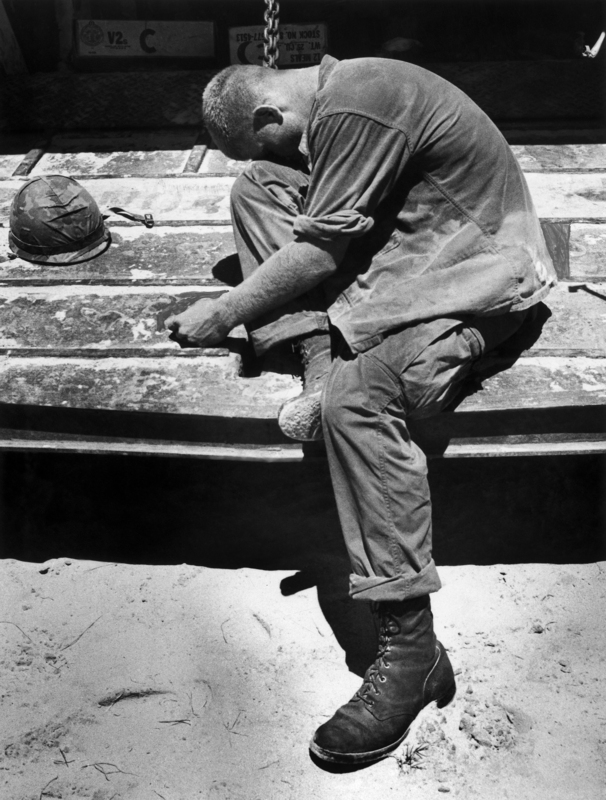 An exhausted marine sobs after carrying wounded and dead marines from a battle on An Hoa Island, South Vietnam, July 9, 1965 by Pulitzer Prize winner Eddie Adams.
An exhausted marine sobs after carrying wounded and dead marines from a battle on An Hoa Island, South Vietnam, July 9, 1965 by Pulitzer Prize winner Eddie Adams.
 American soldiers atop Marble Mountain, on the coast southeast of Da Nang, keep a lookout over soon-to-be-built Marble Mountain Air Facility on November 1, 1965
American soldiers atop Marble Mountain, on the coast southeast of Da Nang, keep a lookout over soon-to-be-built Marble Mountain Air Facility on November 1, 1965
This article was originally published on The Vintage News. com on November 7, 2015

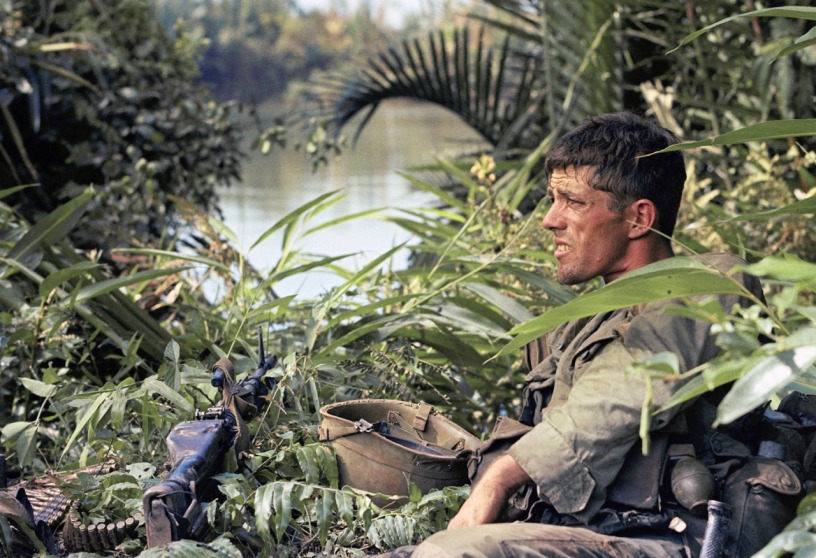


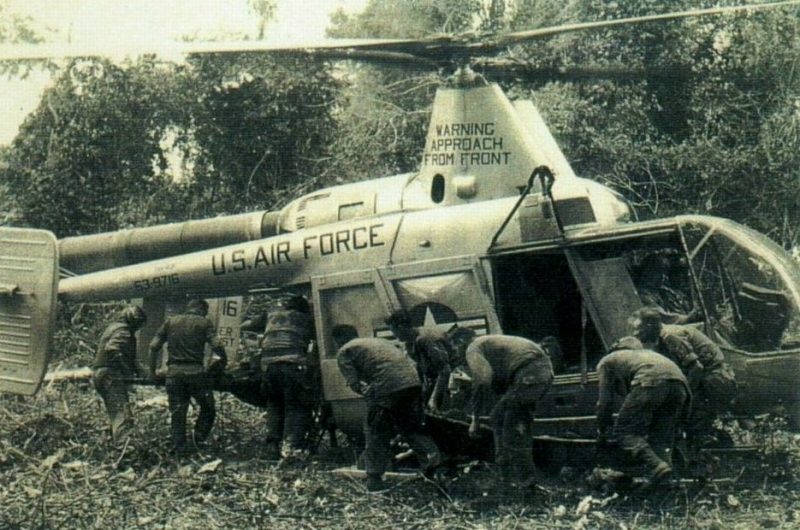
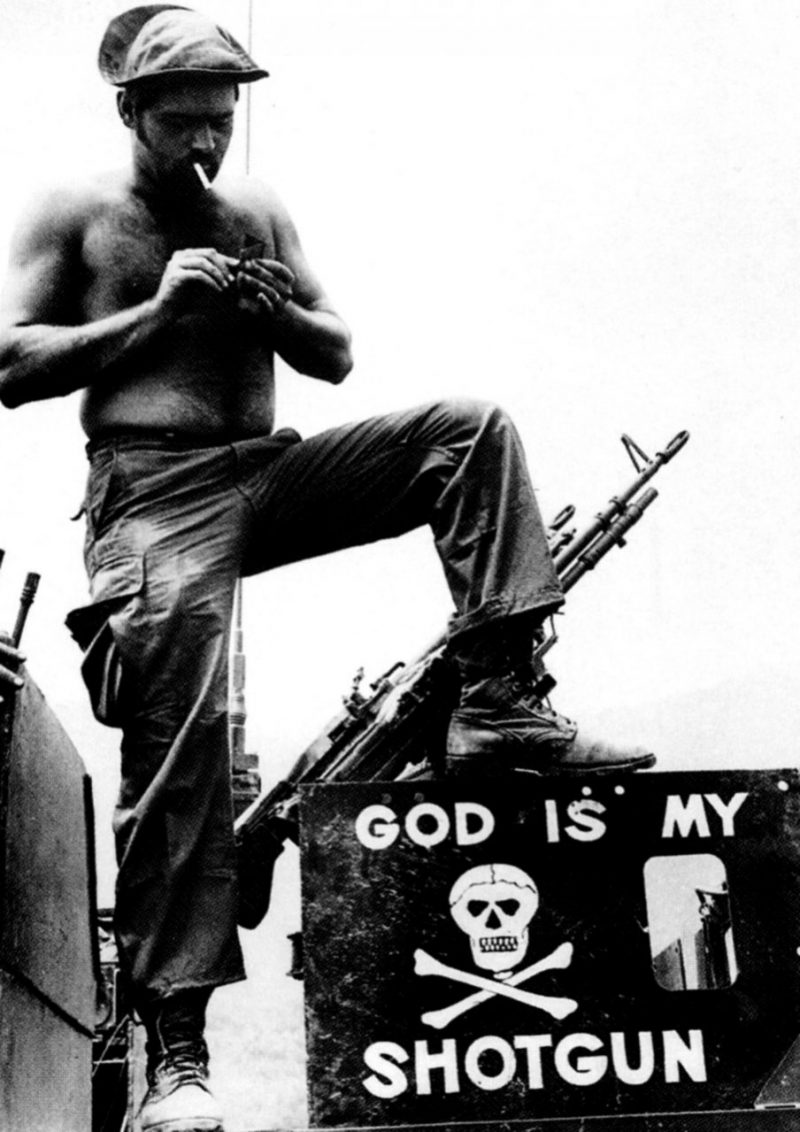
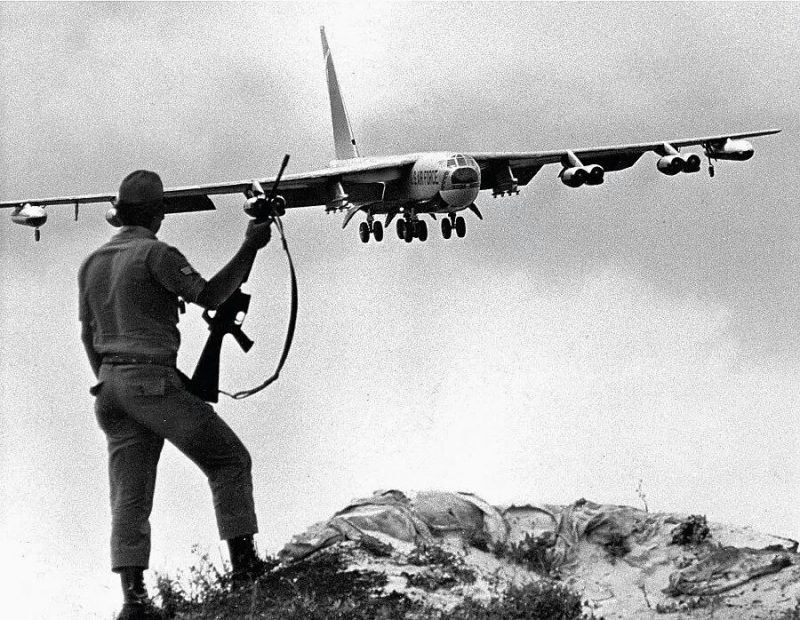
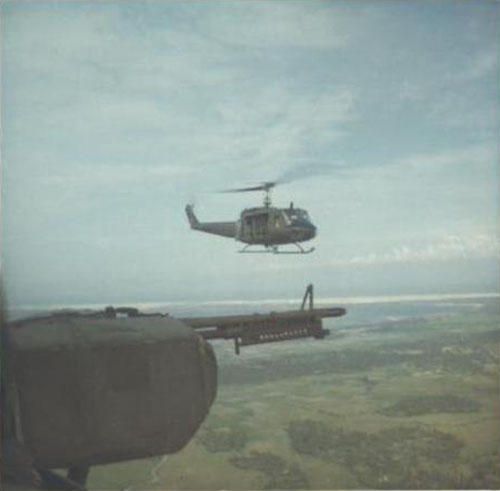
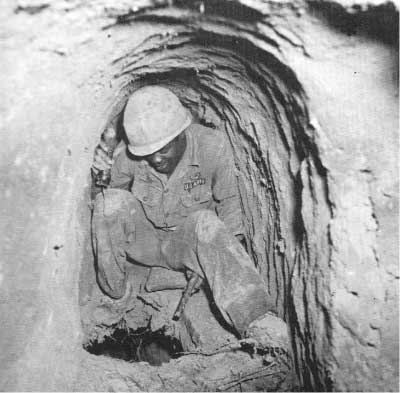
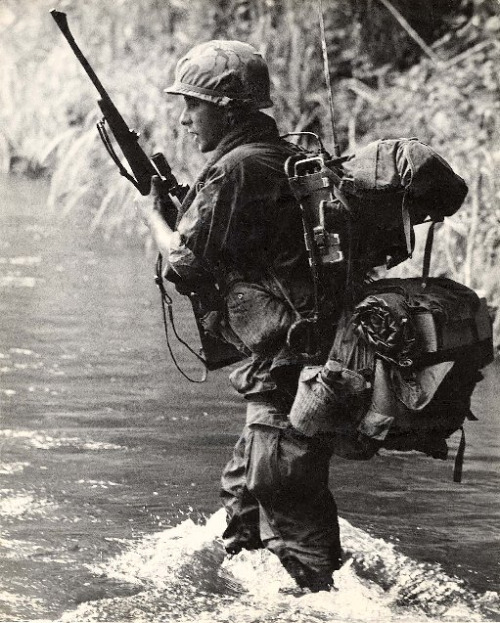
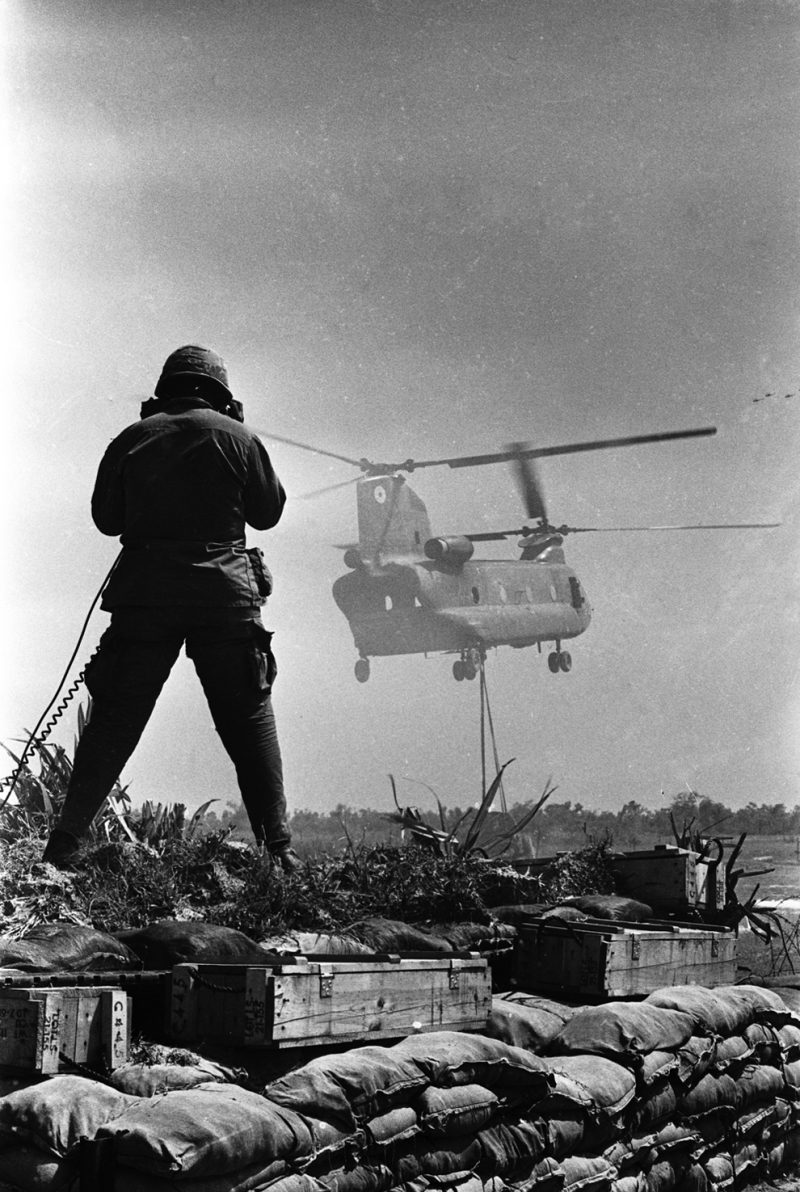
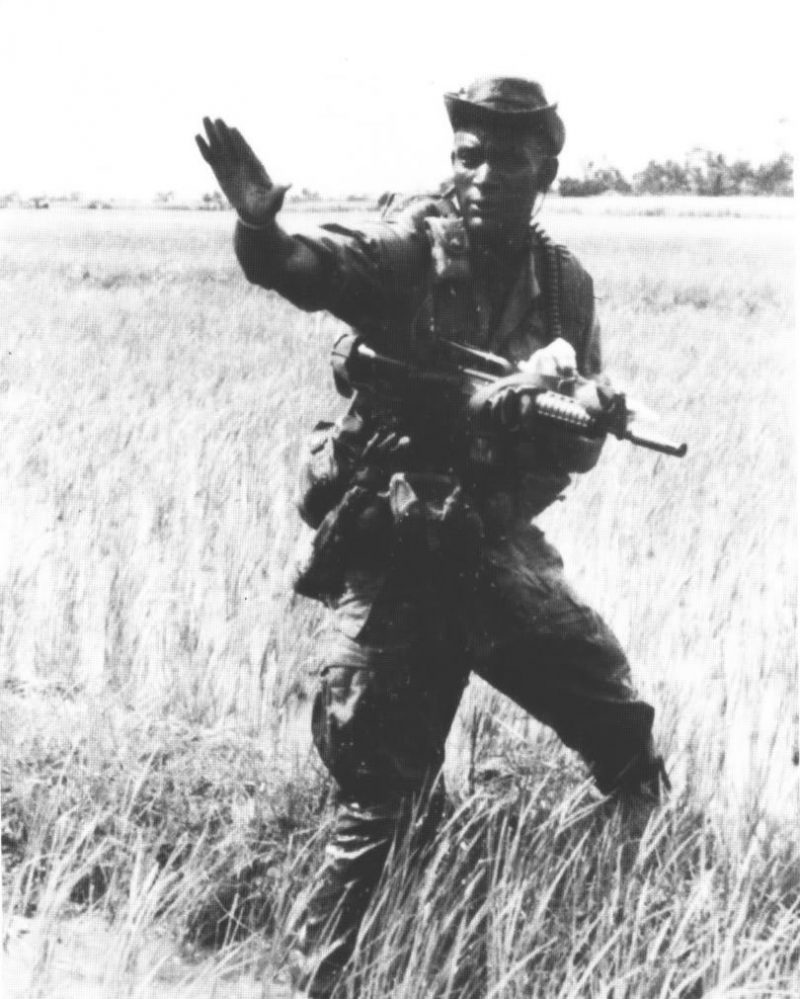
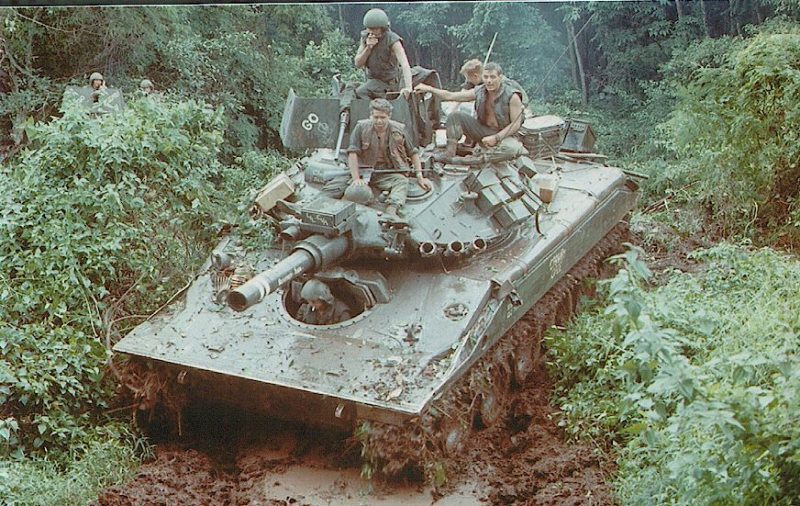
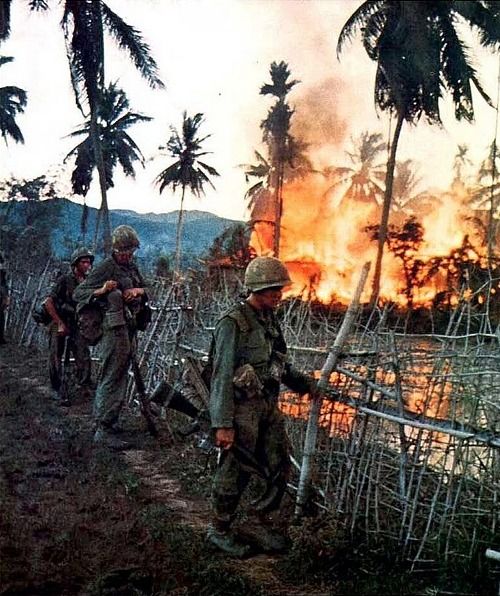
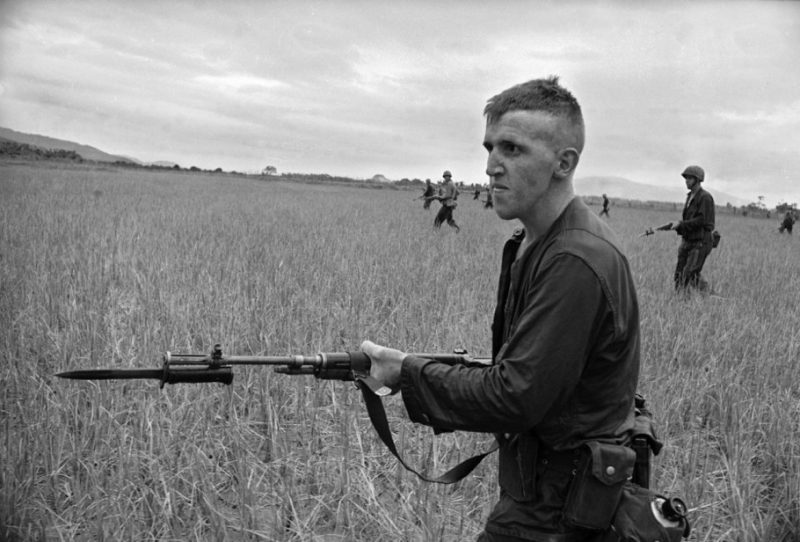
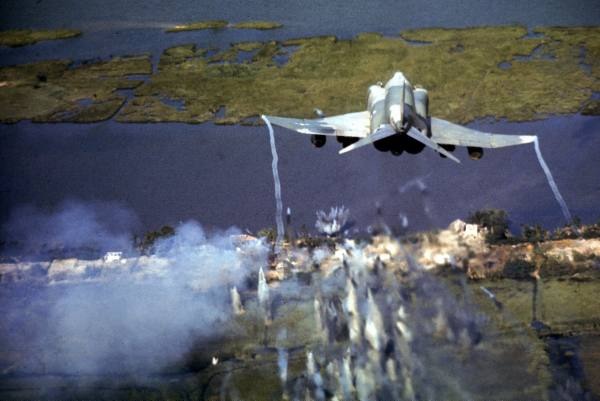
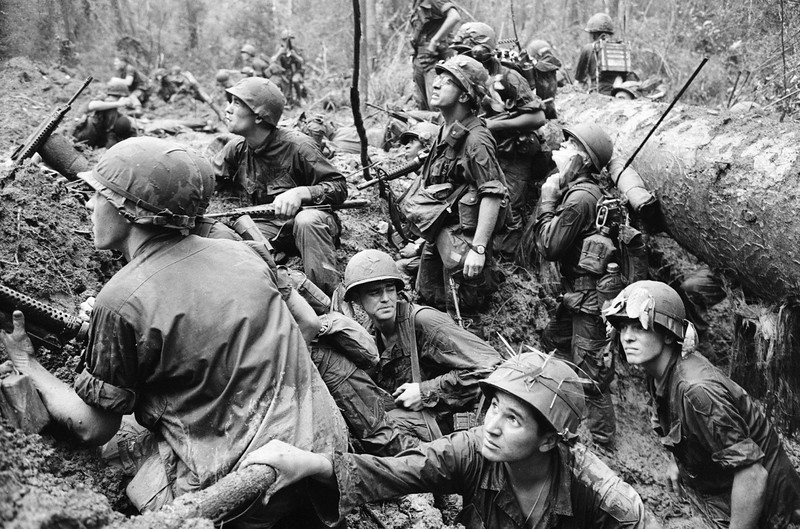
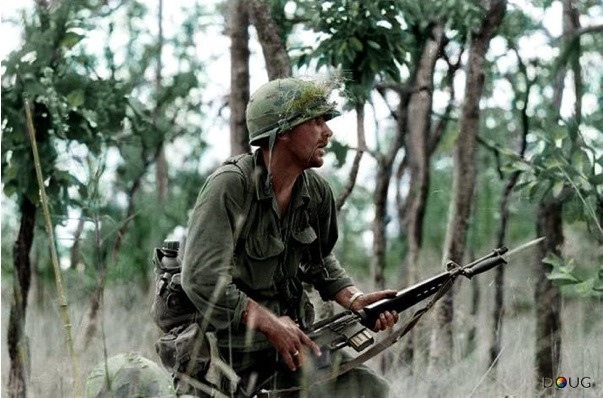
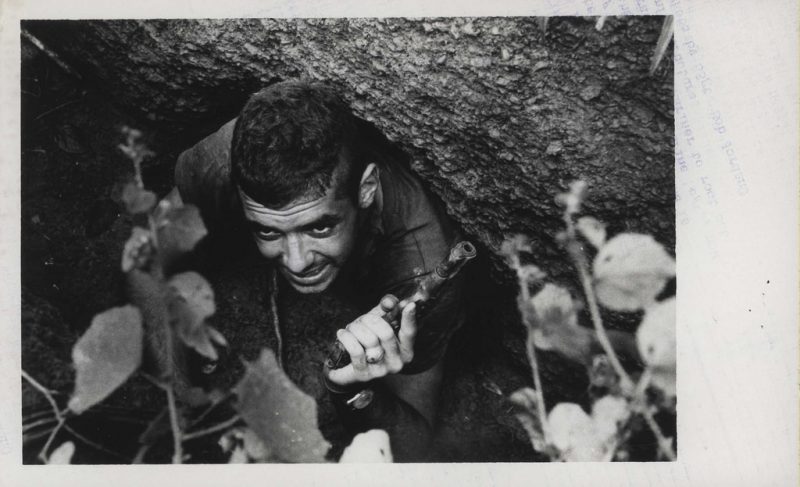


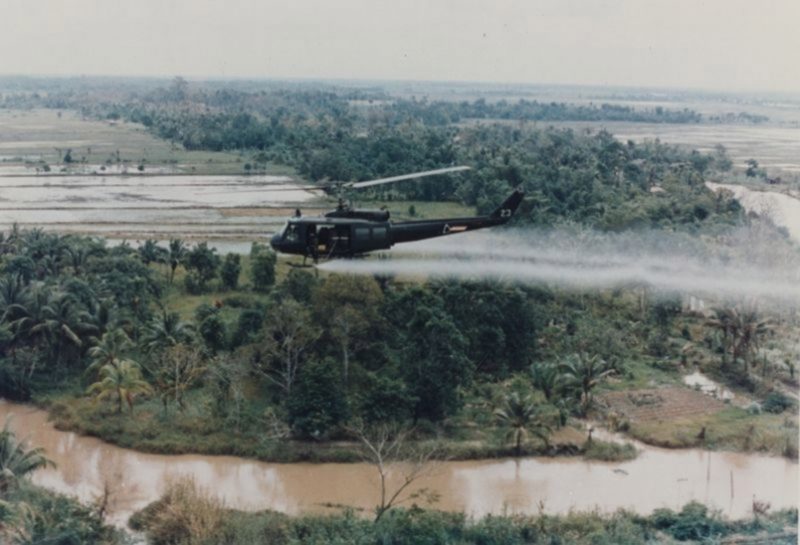
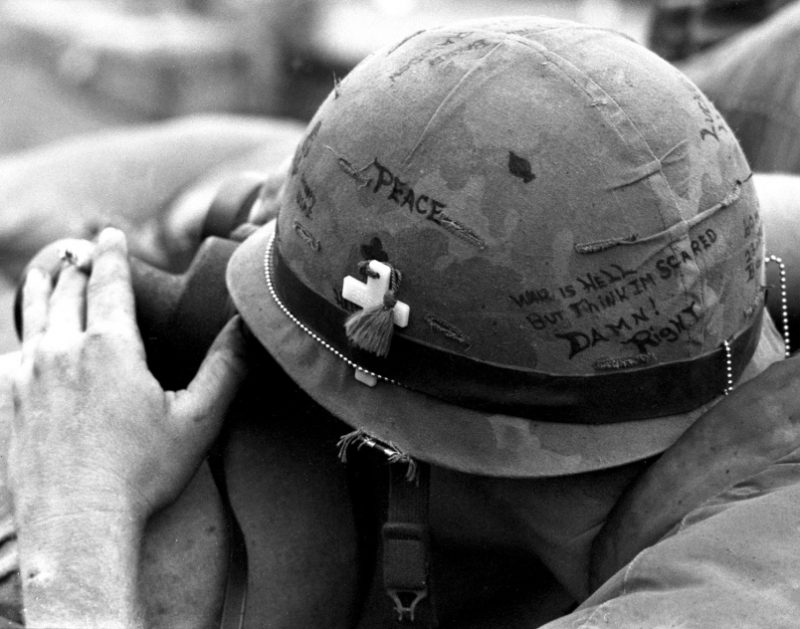
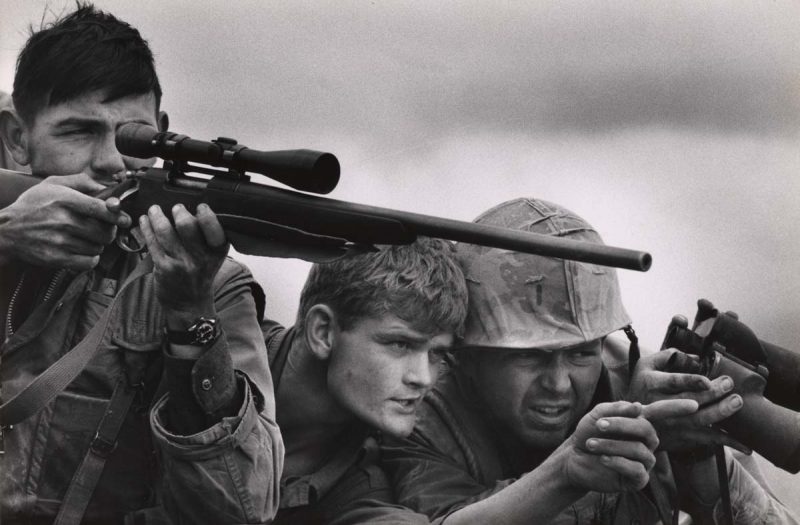
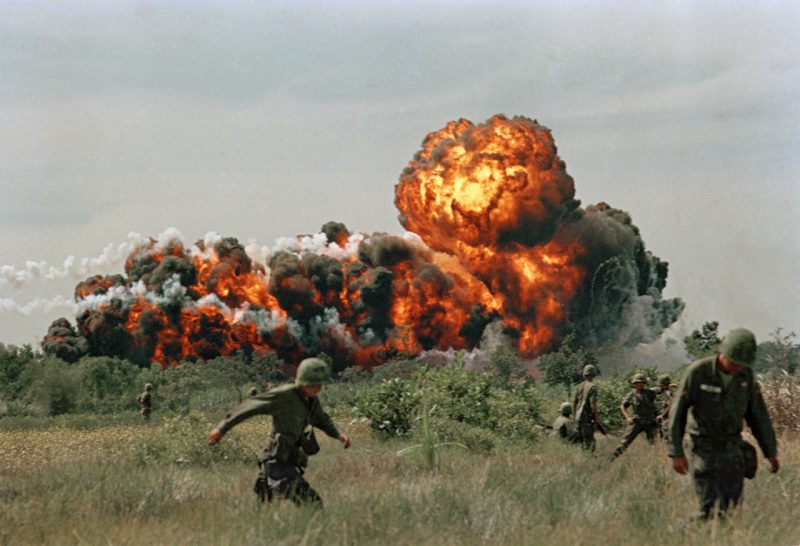
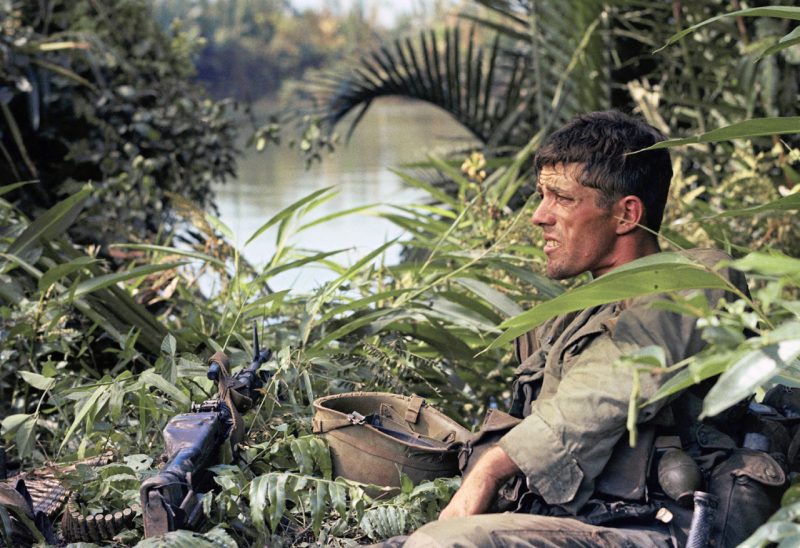

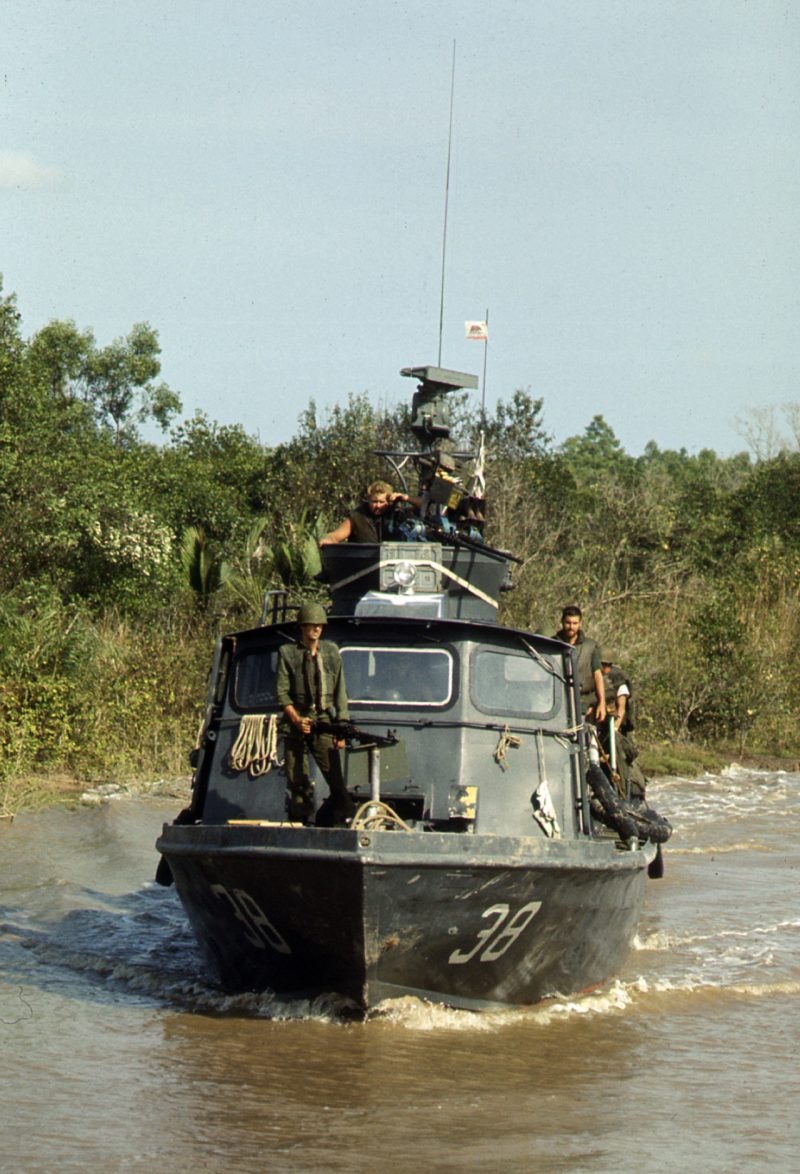
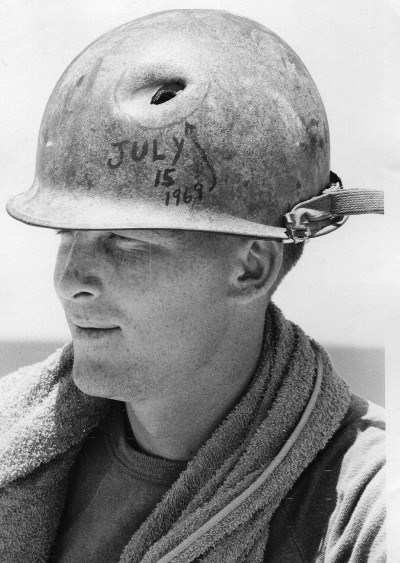

Very informative and well worth reading. I have a special interest here and appreciate all the time and effort taken to put this together
LikeLiked by 1 person
Love the pics, especially the living color. Had one long tour Dec 68 – Dec 69 and two short tours, Jan 73 – Mar 73, Oct 73 – Jan 74. Missed not having your articles but welcome back!!
LikeLiked by 1 person
The lookout on top of Marble Mountain picture…I was at MCAF Marble Mountain in 1965..
LikeLiked by 1 person
Thank all of you for your service. God bless.
LikeLike
Pictures bring back many memories. Arrived in RVN via USNS Upshur 24 Dec 1967. Heavy Artillery Battalion 5/22 Arty 175 – 8″. Supported 4th ID, 5th Special Forces, 1st Cav, 101st Airborne 173rd Airborne, 23rd Arvn Division at various times in II Corps. Stay in touch on nearly a daily basis with about half dozen guys from my unit. We are old men now 52 + years ago. Today I was recognized by a number of people for my service to our country and thanked. I wear a military hat virtually always in public. I am proud of my service as we all should be. Welcome home gentlemen and thank you for the website.
I contributed some info to the 1-14th website nearly 20 years ago. See the link below.
Thank you for this website.
LikeLike
My unit, Mike 3/3 3rd Marine Division, pulled guard for arty guys on LZ Catapult in the extreme NW corner of RVN. You arty guys work your asses off keeping those round going out. It made me glad to be in the grunts. Up on the Z we were under the fan of NVA 152 and 130 arty just across the Ben Hai. Bad news, for sure. Good news was hearing our counter battery fire shutting down the 152s. I said it before, and I’ll say it again, thank you Cannon Cockers.
LikeLike
Thank you brother. It was our duty, mission and pleasure to put rounds on the target ASAP. We all had the same thoughts, get through another day and night and one day closer to getting back to the world and land of the round eyes,
Semper Fi
LikeLike
Great
LikeLike
Commentaries were simple, and direct. We did not philosophy as we concentrated on the mission and survival moment to moment. Facial expressions and body language “… says it all…
LikeLike
These are great photos. They bring back memories. That first pic of the dude being hoisted up to a chopper from Mutters Ridge, and the guy on the radio talking to the chopper pilot, the TACP operator, that is what I did for Mike 3/3 in 1968. Coordinating that, seeing a wounded or sick dude getting out of the Bush, was very rewarding. My callsign for the first 4 months of 68 was Fighting Mad one four Mike.
On Sun, Jun 14, 2020 at 19:48 CherriesWriter – Vietnam War website wrote:
> SP5 Lee commented: “Commentaries were simple, and direct. We did not > philosophy as we concentrated on the mission and survival moment to moment. > Facial expressions and body language “… says it all…” >
LikeLike
The picture of a medevac from Mutters Ridge show the radioman talking to the helicopter lifting a wounded Marine by cable. The Marine on the radio was a TACP tactical air control party. That is what I did for Mike Company 3rd Bn. 3rd Marines in 1968. Besides calling in Birddog spotter planes, helicopter support and jet air strikes, coordinating the med evac of wounded brothers was the most rewarding thing I did during the war. When the LZ was hot (taking fire) the danger was greatest for the wounded man and the air crews in the chopper. Always a Huey gunship, medevac chase bird was suppressing that enemy fire. It took great teamwork, and I was proud to be a part of it.
LikeLike
I read the awards my uncle, Ivan Lester Sage (USMC), received as a helicopter gunner. On reading your statement, I felt the same. The horrors and pain of war I have never known because others paid the price. Lester was the youngest of the family and my uncle Bob was the second oldest. Bob was in the Army and I believe was in VietNam in the section taking care of the soldiers KIA. May peace be in your dreams.
LikeLike
Hi great photos…spent a year, Aug 1966-Aug 1967 but 99% was in Saigon…memories, thanks…came home safe….God Bless the troops who did not…
LikeLiked by 1 person
Wow, Fifty-one years ago. At times it still seems real and others like a bad dream…
My first in-country Christmas was spent South of Hue City. HHB XXIV Corps Artillery.
Our Christmas was relatively quiet that evening and even on Christmas day, it was very quiet. Little did we know the hell that was gaining energy to befall all of us, country-wide, as Tet struck shortly after the Calendar New Year. As a 68W I was swamped for days at a time; sleep 2 hrs., tend 26, off and on, on and off, non-stop.
The following Christmas it was again quiet and I just prayed that there would not be a repeat of the previous years’ experience.
Since that year, Christmas has never been the same. I find myself drifting back to those I tended to, some saved, many not, and it is if for them I will always give my thanks.
Thank all y’all for your service.
LikeLike
WOW, I was the pilot of the helicopter in the picture of the UH-1 helicopter spraying Agent Orange. The call sign for the aircraft was “Warrior two-three” (23) of the 336th Assault Helicopter Company out of Soc Trang Army Airfield in the Mekong delta. I was spraying around the perimeter of the airfield. It would have been in August or September 1968. I have several other pictures of that mission. The pictures were taken by another member of the 336th that was on perimeter guard duty.
LikeLike
Look close at the person sitting in the left door of the helicopter. His name was Specialist -5 Richard (Dick) Morane. Dick died about three years ago from complications related to exposure to Agent Orange.
LikeLike
Appreciate reviewing your the different links to your website. My brother J T Copley, was in the 80th Trans, 121st Aviation, 13th Aviation during his 28 months in Vietnam. Thank You for sharing!
LikeLike
A good collection of photos. For those wondering about the facts regarding service in VN here is an interesting article I have saved for over 20 years. It dispels some of the myths about who served and the number of draftees actually being “in country” Enjoy!
VIETNAM WARRIORS: A STATISTICAL PROFILE IN UNIFORM AND IN COUNTRY
Reprinted from April 1997 VFW magazine.
*Vietnam Vets: 9.7% of their generation
*9,087,000 military personnel served on active duty during the Vietnam era (Aug. 5, 1964-May 7, 1975).
*8,744,000 GIs were on active duty during the war (Aug. 5, 1964-Mar.28, 1973).
*3,403,100 (inc. 514,300 offshore) personnel served in the SEA Theater (Vietnam, Cambodia, Laos, flight crews in Thailand and sailors in adjacent South China Sea waters).
*2,594,000 personnel served within the borders of South Vietnam (Jan. 1, 1965-Mar. 28, 1973).
*Another 50,000 men served in Vietnam between 1960-1964.
*Of the 2.6 million, between 1-1.6 million (40-60%) either fought in combat, provided close support or were at least fairly regularly exposed to enemy attack.
*7,484 women (6,250 or 83% were nurses) served in Vietnam.
*Peak troop strength in Vietnam: 543,482 (Apr. 30, 1969).
CASUALTIES
*Hostile deaths: 47,378
*Non-hostile deaths: 10,800
*Total: 58,202(includes men formerly classified as MIA and casualties). Men who have subsequently died of wounds account for the changing total.
*8 Nurses died–1 was KIA.
*Married men killed-17, 579
*61% of men killed were 21 or younger.
*Highest state death rate: West Virginia-84.1 (Nat’l. avg. 58.9 for every 100,000 males in 1970
*Wounded: 303,704 – 153,329 hospitalized -150,375 injured not req. hospitalization.
*Severely disabled: 75,000–23,214(100%); 5,283 lost limbs; 1.081 sustained multiple amputations.
*Amputation or crippling wounds to the lower extremities were 300% higher than in WWII and 70% higher than in Korea. Multiple amputations occurred at the rate of 18.4% compared to 5.7% in WWII.
*MIA: 2,338
*POWs: 766 (114 died in captivity).
DRAFTEES VS VOLUNTEERS
*25% (648,500) of total forces in country were draftees.
*Draftees accounted for 30.4% (17,725) of combat deaths in Vietnam.
*Reservists killed: 5,977
* Nat’l Guard: 6,140 served; 101 died.
*Total draftees (1965-73): 1,728,344.
*Actually served in Vietnam: 38%
*Marine Corps draft: 42,633.
*Last man drafted: June 30, 1973
RACE AND ETHNIC BACKGROUND
* 88.4% of the men who actually served in Vietnam were Caucasian; 10.6% (275,000) were black; 1% belonged to other races.
* 86.3% of the men who died in Vietnam were Caucasian (includes Hispanics); 12.5% (7,241) were black; 1.2% belonged to other races.
* 170,000 Hispanics served in Vietnam; 3,070 (5.2%) died there.
* 70% of enlisted men killed were of Northwest European descent.
* 86.8% of the men killed as a result of hostile action Caucasian; 12.1%(5,711) were Black; 1.1% belonged to other races.
* 34% of blacks that enlisted volunteered for the combat arms.
* Overall, blacks suffered 12.5% of the deaths in Vietnam at a time when the percentage of blacks of military age was 13.5% of the population.
* Religion of dead: Protestant—64.4%; Catholic—28.9%; other/none—6.7%.
SOCIO-ECONOMIC STATUS
* 76% of the men sent to Vietnam were from lower middle/working class backgrounds.
* Three-fourths had family incomes above the poverty level; 50% were from middle-income backgrounds.
* Some 23% of Vietnam vets had fathers with professional, managerial or technical occupations.
* 79% of the men who served in Vietnam had a high school education or better when they entered the military service. (63% of Korean War vets and only 45% of WWII vets had completed high school upon separation).
* Death by region per 100,000 populations; South–31; West–29.9; Midwest–28.4; Northeast–23.5.
WINNING AND LOSING
* 82% of veterans who saw heavy combat strongly believe the war was lost because of lack of political will.
* Nearly 75% of the public agrees it was a failure of political will, not of arms.
HONORABLE SERVICE
* 97% of Vietnam-era veterans were honorably discharged.
* 91% of actual Vietnam War veterans and 90% of those who saw heavy combat are proud to have served their country.
* 66% of Vietnam vets say they serve again if called upon.
* 87% of the public now holds Vietnam veterans in high esteem.
LikeLiked by 1 person
Thanks bro for the information. I’m most appreciative. / John
On Sun, May 5, 2019 at 5:34 PM CherriesWriter – Vietnam War website wrote:
>
LikeLike
Sad to see this pictures. Bringing back a lot of memories I was there 66 -67 Pleiku. 1 / 22 Inf. 4th Inf. Div. Most of the time in the Central Highlands jumgle.
LikeLike
It is good to see the dedication of our vets and the love for each other. I am x-Marine 59-63 and missed the action. My Brother served in Nam and retired from the USMC as M/Sgt. We are so proud of his service and all that served and serving.
LikeLiked by 1 person
Very well made site. I am back in school taking web page design and will ever be returning to check yours.
LikeLike
Lot of great comments. I was at Ton Son Nhut, Dec 68 – Dec 69. Assigned to Det 1, 834th Air Div, C-130. First couple of weeks, I would notice C-141 park on the ramp in front of ops and unload metal boxes. A couple of days later, metal boxes would be on loaded. I finally asked what was the deal with the metal boxes. One answer KIA. That is when you realize the loss of life. Two guys I went to school with, Jim Claybaugh and Tom Foreman were KIA the early part of 69 and brought to the mortuary at Ton Son Nhut. Reality sets in real fast when someone you know becomes KIA.
LikeLike
Did you know, John Ballard, he was in charge of the mortuary , 66 68 time frame
LikeLike
Hi pdoggBiker Your article rings true with my brother’s experience. My four older brothers all served in in country/Vietnam 1966-67-1968-70- 1971-72 .
(PFCVernon 173rd KIA, Tech Sgt.Tony AF Spooky Gunner, Cpl. Bill 25th Infantry and S.SgtDavid 5th Regiment/ 1st Cav Air Mobile) This a good article. The photos are important for the youth of tomorrow.
I agree with the draft being good for the nation’s young and our countries fiber. S. Sgt David had two volunteers with Commissioned and Snr.NonCom, rank turn and run in battle. Also, my brothers split 2 drafted 2 Volunteered. I was drafted too and saved by the amendment to the Sole surviving son Act January 7th 1972 from being sent over as a Recon Scout.
Walter B.
LikeLike
I liked it .
LikeLiked by 1 person
The photo of the “Sad, lonely & tough…” soldier (sitting) is Wayne Thomas Stevens. He died 22 Apr 2007 and was interred at Ft. Rosecrans National Cemetery.
LikeLiked by 1 person
Thank you Bonnie for the information. May Wayne rest in peace!
On Sat, Jan 14, 2017 at 7:08 PM, Cherries – A Vietnam War Novel wrote:
>
LikeLike
Great article. It brings back some very sad memories.
LikeLike
The RTO with the low pack has put it that way so he can drop it quickly and still keep the radio on the ruck. RTO came up with all sorts of ideas to help carry the PRC-25 radio. They had to keep a spare battery and the long antenna with them at all times, and since just the radio was heavy the ruck frame carried the weight better.
LikeLiked by 3 people
Can someone provide accurate information on what
went on at death valley in Vietnam. I have read a
few stories and would like a more accurate account on what went on. I appreciate the updates.photos would be nice.Again I feel for all those who went to Nam because not did the American introduction changed the course the war but how we live today in other parts of the world.You sacrificed so many lives that millions of people globally can have freedom.
LikeLike
First, I didn’t serve in that area. Death Valley was ‘down south ‘ and not sure of spelling but Que Son area, I believe. The best people to talk to about it would be marines from the 1st Mar Div, predominantly 5th and 7th Marine Regiments. They served there extensively, running many operations there. If memory serves, Army — Americal Division along w possibly 196th which may have been airborne — served in that area also. I think 1969, there were many ops there and it wasn’t the Americal Div finest hour . Leadership issues from the top , down failed the troops in getting them prepared , motivated with discipline being very lax creating more issues. Keith Nolan wrote a book ‘Into Cambodia ‘ where good leadership turned around several divisions and would be a good place to understand the impact of leadership and unit effectiveness, performance. If you also take into account that those divisions had a fair number of ‘conscripts ‘, it could be used as additional pro draft , conscription position vs the ‘all volunteer ‘ position that most people nowadays are brainwashed into.
Death Valley, over time, the NVA had moved at least 1 well equipped, well supplied Division there. Just to clarify, NVA were well trained, equipped, supplied and organized as any modern military and had many 20+ yr combat veterans. The marines continuously ran operations there and NVA continuously opposed, receiving replacements and supplies throughout. The fighting there was somewhat atypical of the hill and border fighting throughout the war. Marines continuously attacking NVA positions despite being outmanned , outgunned throughout.
Former senator from Virginia, James Webb, was there, I believe, as marine plt cmdr, Co cmdr and was wounded and decorated in actions there. He wrote a book called ‘Fields of Fire’ that occurred there. While Fiction, it pretty much describes the fighting, conditions there. Also known to Marines as the ‘Arizona Territory ‘. I’ve read Keith Nolan quite a bit and he has a book called ‘Death Valley ‘ which I did not read. However, I’ve been told that it wasn’t one of his better books and there are a number of glaring errors. What I heard was from marines who were there.
Last, Death Valley in the Arizona is often mistaken with the battles of Ia Drang and A Shau. It was an area south of Da Nang that became a killing field of NVA and marines. Just as a point of reference, we attacked the same hill that was only about 1400 meters from us, peak to peak, 3 times in a span of less than a month and the casualties were equivalent to entire marine rifle co. You could look at Death Valley, Arizona territory same way.
LikeLiked by 1 person
Thank you sir.
On Saturday, November 12, 2016, Cherries – A Vietnam War Novel wrote: > Sgt Maj EMP commented: “First, I didn’t serve in that area. Death Valley was ‘down south ‘ and not sure of spelling but Que Son area, I believe. The best people to talk to about it would be marines from the 1st Mar Div, predominantly 5th and 7th Marine Regiments. They served the” >
LikeLike
Thank you sgt maj, I was where you talk about in 1970 and did many ambush’s in Arizona, but didn’t know it was called Death Valley, iam 68 now and only remember the bad shit, but there was two hills there, one pretty big one and little village in the middle, then a smaller hill, which I was one,was that hill 69 ????? It was also by a big mountain that I thought was Charlie ridge, we did alotopes up there too, or was it marble mountain ???? I think I was 2/3, we also went tododge city but that was a ride away: thank you Sara I was in 2/3 in Calfornia before Japan, buy miss my Foyt to nam, day late , so don’t remember the real unit I was in. Thank you, j rhone
LikeLike
After 2nd paragraph , lost interest. ‘Communist regime of North Vietnam….. and Viet Cong allies’? By 67, most of us fought NVA — better armed, well trained, organized w communications as any other modern military, well supplied, fanatical and led by their 20+ yr combat veterans that didn’t like losing. Heck, a good portion of NVA were vets until md 68 before we started running into units that were a little rough around the edges. OH, anybody mention outmanned, especially hill and border fights. NVA often chose contested areas and the marines , in their arrogance, didn’t care. Can’t speak for Army.
Went looking a bit and ran across Platoon bit and ya lost me with the cast being high to add realism? Are you daft? We may have been young and crazy, but learned pretty quick what dead meant. And when you figured out, and it didn’t take long, that neither side was keen on POW’s, HIGH = Dead, don’t gotta be a math genius to figure it out.
USMC had more casualties in Vietnam than in any other war and we only had 2 under strength divisions for about 5 years? Then look at all of the casualties, or you can be clever and just get casualties from combat arms. Then break it down any which way you want — race, age, gender — and your politically correct, revisionist history then needs a lot of rewriting.
Last, guess I’m lost or I don’t get it. There’s a ton of photos out there that are a heck of lot sadder , thought provoking.
Maybe you done good with your book but using the word ‘cherries’ wasn’t in the top 5 for targets, fresh meat, FNGs……
It’s the thought that counts, right? Welcome home….. Bull, take it and stuff it. Nobody really cares until political, military, media need to dump on us — over n over, it doesn’t stop.
LikeLiked by 1 person
Thanks for the commentary Sgt. Maj. Don’t forget that over 2.5 million troops served in VN over the course of the war and each has a story to tell. No two – even witnessing the same event will be the same! “Cherries” was prominently used in the 25th Division in addition to fresh meat and FNG’s even though it was unheard of up north or with the Marines or 101st Army. Later in the war, drugs was also an issue and troops took obscene chances getting high – some even in the bush. It was common place in the 70’s and thus, mentioning it, provides realism for those who served during that part of the war. I do agree with the photos…
Thank you for your service and Welcome Back to the World! Semper Fi!
LikeLike
Thanks.
Got out , was lost and rejoined doing over 35 years. HATED lifers through out but loved troops and kept me in, didn’t even notice until they told me it was time. Was lucky in Nam that I had plt Sgt and Co gy , over time n w some overlap,that were WWII n Korea. My mentors, heroes of sorts. Don’t know how I got Sgt Maj n an infantry regiment in last billet. Had some guardian angels that took a like to me. Have more letters of reprimand than any drawer could hold– my angels looking out for me vs military judicial system. Decking a Captain, hazing as in just pinning on the stripes in formation as 1st Sgt, rifle co. Could go on, AND ON, but you get the point in having some angels on your side.
Made the rounds and way too many joint operations w live rounds inc Shield, Storm, Storm II.
I did 2 in Nam because of 1 sibling rule, my brother wouldn’t have been able to hang. So I was there, hill and border fights up north, 67-68-69. Grew up on west side of Chicago and almost everyone went, drafted. Quite a few ended up along Cambodia AND Into Cambodia , all mostly grunts. Division Street Spartans were well represented and a lot in 70s.
Just saying and I’ll agree to disagree regarding drugs. Bush, pretty much a no-no across board, however any camp — base, fire, forward — another story. I know, CBS had this guy w shotgun n weed n ….. Whatever.
One last comment, believe in conscription and history shows some of the most successful and baddest were conscripted militaries. Most people don’t realize that conscription doesn’t mean everyone drafted. Don’t know what the ratio for Nam was — Cadre/Professional, volunteers, drafted — but ratio maintained throughout was healthy balance. 70-30? Don’t believe today’s military, political understand what conscripts bring to party and their impact. Marines had to draft in 68 because of all the casualties. Believe it was up to 10% of force and you couldn’t tell difference. They were successfully ‘brainwashed’ as all of us, ticked from get go, fought like tigers And they were brothers
Thanks again, appreciate time, effort n what your trying to do.
LikeLiked by 1 person
God bless!
On Nov 3, 2016 7:36 PM, “Cherries – A Vietnam War Novel” wrote:
>
LikeLike
Yes; we had draftees in 1969 and they were just as good as any other Marines! I’m convinced that the draft was really good for the whole country.. it made us all feel like we had “skin in the game.”.. actually i had more respect for the draftees because they weren’t using it to advance a military career.. the Way career military guys like myself knew we were doing… the draftees were doing it out of a true sense of duty usually.. I was also convinced that any of them could have found a way to avoid it if they were determined not to go. The draftees always had my highest respect!
LikeLike
I was drafted 15 July 1953 and the Korean War ended 12 days later. Took Basic at Camp Atterbury, Indiana with Easy Co, 155 Inf Regt, 31st Infantry Division. Shipped to Camp Carson and received Summary Martial for breaking restriction. Shipped to Germany and assigned to 44th Chemical Co, Smoke Generator, 4th Chemical Bn. Always stayed in trouble but in those days Army had no Article 15’s, you signed the Company Punishment Book and when you left the unit nothing from the book was forwarded to your new assignment.
LikeLike
I think that was a far better disciplinary system than the Army has today. Back then when a young soldier screwed up it didn’t ruin his career. Today one screw-up and you kiss your career goodbye.
LikeLike
You say, “No two – even witnessing the same event will be the same! ”
The very thing Major Green told me when we discussed how stories could be so different.
I wrote a narrative about my time as a Army Rotary Wing pilot,
“Slick Driver”, I plan on publishing it on KIndle and was searching for a front cover picture, (seems the pics I took lack the flaming action Editors believe sell books.)
Anyway until my wife puts a price on it and offers it on Kindle, You may read it free on my Facebook page , under notes,
Bobby Ingram (Blucross)
CW2 , 101st AHB
Blackwidows
I corps 1968 69
LikeLiked by 1 person
I’ll take you up on reading your future book and provide feedback when finished. Thanks!
LikeLike
Thank you for all the pages.I was looking for MACV logo and pedro med dustoff when it was linked to yours.After reading all your pages, I now know why some guys and gals put a gun to their head.Am really tired out after this long bout of war.Depressed and worn out.Battle fatigued.
LikeLike
Tough to put into words.
LikeLike
Very interesting. How come no story on Marine Dog Handlers.( Scout Dog ) Was one in 1966-67
LikeLike
You’re welcome to write an article about it and I’ll post it on the website. Let me know. / John
On Jul 17, 2016 7:02 PM, “Cherries – A Vietnam War Novel” wrote:
>
LikeLike
nobody commented on post.
LikeLiked by 1 person
Outstanding
LikeLike
thank you so much for making me a better student of the war in vietnam! my tie to the war started at birth! I was born in FT. rucker U.S. ARMY helicopter pilot training base in Alabama! IN “1962” (the coming of age of the helicopter) my father was a helicopter mechanic. & as I got older & started asking questains about vietnam (because of what i saw every night on T.V.) my dad told me that in his first 6 months everyone wondered why soooooo many new pilots were being trained at such a rapid pace? in my opinion & my father P.F.C. Donald larwence Dutro. & most of the bases mechanics(that had a 4 year hitch There! & saw pilot training quotas keep going up! along with more & more trainers(helicopters)arriving. strongly thought even in “63” that something was not adding-up? I am & always will be heartbroken when watching Saigon fall on the day after my “13”th birthday! apr/30/75 my father died at 65 years of age(his death was NOT Vietnam(he was never there!) or army related! However (& i dont know why?) the war in vietnam is Very close to my heart! and I will never tire of learning MORE about it! hey vietnam vets I know you guys are dissapering at an ALARMING rate! but i promise you the nation will never forget you as long as I am still breathing! thank you for teaching me more about what it was to be a REAL Vietnam veteren! I loved president Richard millhouse Nixon! (this is where my dad & me differed) even though i am so much younger then y’al I dont think we will be alive to see the sure end of The Once greatest nation on earth! I salute you! & Thank you!
LikeLiked by 2 people
Yes it’s very true that the VN war has also had huge impact on people who were never there..
LikeLiked by 1 person
Thank you for your support. I was one of those helicopter pilots, did two tours in Vietnam. Had some interesting things occur and saw many things that made you step back and think, both from the positive and negative sides.
LikeLike
Thank you for your service, I know it made your life hard, I was married to a Vietnam veteran.
LikeLiked by 1 person
Very good I was there 67 68 70 71 with 5th special forces and 25th ARVN
LikeLiked by 1 person
Some never before seen pics for me, good stuff. On the 6th one up from the bottom, that’s a Douglas Skyraider pulling up after dropping White Phosphorous, a/k/a Willie P.
LikeLiked by 1 person
Thanks Chris! I’ll add the words under the picture. I do appreciate it!
LikeLike
Really good …Kind of brings back memories …sad war Thanks for the article
LikeLiked by 1 person
Great photos, The last photo caption should read: American soldiers atop Marble Mountain, on the coast southeast of Da Nang, keep a lookout over soon-to-be-built Marble Mountain Air Facility. Thanks, BillWilliam Stilwagen, Bush GuideVIETNAM Battlefield Tourshttp://www.vietnambattlefieldtours.com/
“There are a thousand hacking at the branches of evil to one who is striking at the root.” – Henry David Thoreau
From: Cherries – A Vietnam War Novel To: lzflashback@yahoo.com Sent: Thursday, July 7, 2016 2:10 PM Subject: [New post] 29 Sad, lonely & Tough Images from the Vietnam War #yiv9524060815 a:hover {color:red;}#yiv9524060815 a {text-decoration:none;color:#0088cc;}#yiv9524060815 a.yiv9524060815primaryactionlink:link, #yiv9524060815 a.yiv9524060815primaryactionlink:visited {background-color:#2585B2;color:#fff;}#yiv9524060815 a.yiv9524060815primaryactionlink:hover, #yiv9524060815 a.yiv9524060815primaryactionlink:active {background-color:#11729E;color:#fff;}#yiv9524060815 WordPress.com | pdoggbiker posted: “War dominated 30 years of Vietnam’s history last century. The struggle that began with communists fighting French colonial power in the 1940s did not end until they seized Saigon and control of the whole country in 1975. The period that Americans refer ” | |
LikeLike
Thanks Bill! I made the change. Appreciate the heads-up! / John
On Thu, Jul 7, 2016 at 2:31 PM, Cherries – A Vietnam War Novel wrote:
>
LikeLike
Is that Bill Stillwagen from Long Island?
LikeLike